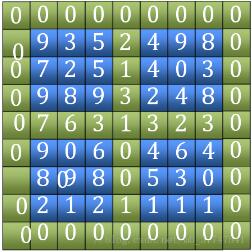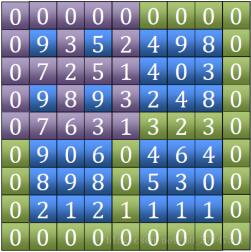 Backend Development
Backend Development Python Tutorial
Python Tutorial How to obtain the local peak value of a two-dimensional array in Python
How to obtain the local peak value of a two-dimensional array in PythonHow to obtain the local peak value of a two-dimensional array in Python
This time I will show you how to obtain the local peak value of a two-dimensional array in python Get up and take a look. The meaning of the question is roughly to find a local peak in an n*m two-dimensional array. The peak value is required to be greater than the four adjacent elements (outside the array boundary is regarded as negative infinity). For example, if we finally find the peak value A[j][i], then A[j][i] > A[j 1][i ] && A[j][i] > A[j-1][i] && A[j][i] > A[j][i 1] && A[j][i] > A[ j][i-1]. Returns the coordinates and value of this peak.
Of course, the simplest and most direct method is to traverse all array elements to determine whether they are peak values. The time complexity is O(n^2) Then optimize a little more to find the value of each row (column) Maximum value, and then find the peak value of the maximum value column through the dichotomy method (the specific method can be seen inOne-dimensional array
finding the peak value). The time complexity of this algorithm is O(logn)What is discussed here is an algorithm with a complexity of O(n). The algorithm idea is divided into the following steps:1. Find "Tian "Character. Including the four outer edges and the two horizontal and vertical edges in the middle (the green part in the picture), compare their sizes and find the position of the maximum value.
(7 in the picture)


As to why there must be a peak within the range we choose, you can think of it this way, first we have a circle, we It is known that there is at least one element in a circle that is greater than all the elements in this circle. So, is there a maximum value in this circle?
It may be a bit convoluted, but if you think about it more, you should be able to understand it, and you can also use mathematical proof by contradiction to prove it. After we understand the algorithm, the next step is to implement the code. The language I use here is python (I am new to python, so please forgive me for some usages that may not be concise enough). Let’s start with the code:import numpy as np def max_sit(*n): #返回最大元素的位置 temp = 0 sit = 0 for i in range(len(n)): if(n[i]>temp): temp = n[i] sit = i return sit def dp(s1,s2,e1,e2): m1 = int((e1-s1)/2)+s1 #row m2 = int((e2-s1)/2)+s2 #col nub = e1-s1 temp = 0 sit_row = 0 sit_col = 0 for i in range(nub): t = max_sit(list[s1][s2+i], #第一排 list[m1][s2+i], #中间排 list[e1][s2+i], #最后排 list[s1+i][s2], #第一列 list[s1+i][m2], #中间列 list[s1+i][e2], #最后列 temp) if(t==6): pass elif(t==0): temp = list[s1][s2+i] sit_row = s1 sit_col = s2+i elif(t==1): temp = list[m1][s2+i] sit_row = m1 sit_col = s2+i elif(t==2): temp = list[e1][s2+i] sit_row = e1 sit_col = s2+i elif(t==3): temp = list[s1+i][s2] sit_row = s1+i sit_row = s2 elif(t==4): temp = list[s1+i][m2] sit_row = s1+i sit_col = m2 elif(t==5): temp = list[s1+i][e2] sit_row = s1+i sit_col = m2 t = max_sit(list[sit_row][sit_col], #中 list[sit_row-1][sit_col], #上 list[sit_row+1][sit_col], #下 list[sit_row][sit_col-1], #左 list[sit_row][sit_col+1]) #右 if(t==0): return [sit_row-1,sit_col-1] elif(t==1): sit_row-=1 elif(t==2): sit_row+=1 elif(t==3): sit_col-=1 elif(t==4): sit_col+=1 if(sit_row<m1 f list for row_n col_n ans_sit print f.close>First of all My input is written in a txt text file and converted into a two-dimensional array through <p style="text-align: left;">string</p>. The specific conversion process can be seen in my previous blog - <p style="text-align: left;">Converting a string to a two-dimensional array in python <a href="http://www.php.cn/wiki/57.html" target="_blank">. (It should be noted that if the list after splitting in </a>windows environment<strong> does not have an empty tail, there is no need to add the sentence list.pop()). Some changes are that I added a "0" wall around the two-dimensional array. Adding a wall eliminates the need to consider boundary issues when we judge peak values. </strong><a href="http://www.php.cn/php/php-Windows-environment.html" target="_blank">max_sit(*n) function is used to find the position of the maximum value among multiple values and return its position. Python's built-in max function can only return the maximum value, so you still need to write it yourself, *n means Indefinite length parameters, because I need to use this function when comparing Tian and Ten (judging peak values) </a></p> <pre class="brush:php;toolbar:false">def max_sit(*n): #返回最大元素的位置 temp = 0 sit = 0 for i in range(len(n)): if(n[i]>temp): temp = n[i] sit = i return sitdp(s1,s2,e1,e2) The four parameters in the function can be seen as startx, starty, endx, endy. That is, we look for the coordinate values of the upper left corner and lower right corner of the range. m1 and m2 are the middle values of row and col respectively, which is the middle of the word Tian.
def dp(s1,s2,e1,e2): m1 = int((e1-s1)/2)+s1 #row m2 = int((e2-s1)/2)+s2 #colCompare the values in 3 rows and 3 columns in order to find the maximum value. Note that the two-dimensional array is required to be a square. If it is a rectangle, it needs to be adjusted.
for i in range(nub): t = max_sit(list[s1][s2+i], #第一排 list[m1][s2+i], #中间排 list[e1][s2+i], #最后排 list[s1+i][s2], #第一列 list[s1+i][m2], #中间列 list[s1+i][e2], #最后列 temp) if(t==6): pass elif(t==0): temp = list[s1][s2+i] sit_row = s1 sit_col = s2+i elif(t==1): temp = list[m1][s2+i] sit_row = m1 sit_col = s2+i elif(t==2): temp = list[e1][s2+i] sit_row = e1 sit_col = s2+i elif(t==3): temp = list[s1+i][s2] sit_row = s1+i sit_row = s2 elif(t==4): temp = list[s1+i][m2] sit_row = s1+i sit_row = m2 elif(t==5): temp = list[s1+i][e2] sit_row = s1+i sit_row = m2Judge whether the maximum value in the word Tian is peak value, and cannot find the adjacent maximum value
t = max_sit(list[sit_row][sit_col], #中 list[sit_row-1][sit_col], #上 list[sit_row+1][sit_col], #下 list[sit_row][sit_col-1], #左 list[sit_row][sit_col+1]) #右 if(t==0): return [sit_row-1,sit_col-1] elif(t==1): sit_row-=1 elif(t==2): sit_row+=1 elif(t==3): sit_col-=1 elif(t==4): sit_col+=1Narrow the range and solve it recursively
if(sit_row<m1>Okay, the code analysis is basically completed here. If there is anything unclear, please leave a message below. <p style="text-align: left;"></p>In addition to this algorithm, I also wrote a greedy algorithm to solve this problem. Unfortunately, the algorithm complexity is still O(n^2) in the worst case, QAQ. <p style="text-align: left;"></p>
<p style="text-align: left;">大体的思路就是从中间位置起找相邻4个点中最大的点,继续把该点来找相邻最大点,最后一定会找到一个峰值点,有兴趣的可以看一下,上代码:</p>
<pre class="brush:php;toolbar:false">#!/usr/bin/python3
def dp(n):
temp = (str[n],str[n-9],str[n-1],str[n+1],str[n+9]) #中 上 左 右 下
sit = temp.index(max(temp))
if(sit==0):
return str[n]
elif(sit==1):
return dp(n-9)
elif(sit==2):
return dp(n-1)
elif(sit==3):
return dp(n+1)
else:
return dp(n+9)
f = open("/home/nancy/桌面/demo.txt","r")
list = f.read()
list = list.replace(" ","").split() #转换为列表
row = len(list)
col = len(list[0])
str="0"*(col+3)
for x in list: #加围墙 二维变一维
str+=x+"00"
str+="0"*(col+1)
mid = int(len(str)/2)
print(str,mid)
p = dp(mid)
print (p)
f.close()
相信看了本文案例你已经掌握了方法,更多精彩请关注php中文网其它相关文章!
推荐阅读:
The above is the detailed content of How to obtain the local peak value of a two-dimensional array in Python. For more information, please follow other related articles on the PHP Chinese website!
 How do you append elements to a Python array?Apr 30, 2025 am 12:19 AM
How do you append elements to a Python array?Apr 30, 2025 am 12:19 AMInPython,youappendelementstoalistusingtheappend()method.1)Useappend()forsingleelements:my_list.append(4).2)Useextend()or =formultipleelements:my_list.extend(another_list)ormy_list =[4,5,6].3)Useinsert()forspecificpositions:my_list.insert(1,5).Beaware
 How do you debug shebang-related issues?Apr 30, 2025 am 12:17 AM
How do you debug shebang-related issues?Apr 30, 2025 am 12:17 AMThe methods to debug the shebang problem include: 1. Check the shebang line to make sure it is the first line of the script and there are no prefixed spaces; 2. Verify whether the interpreter path is correct; 3. Call the interpreter directly to run the script to isolate the shebang problem; 4. Use strace or trusts to track the system calls; 5. Check the impact of environment variables on shebang.
 How do you remove elements from a Python array?Apr 30, 2025 am 12:16 AM
How do you remove elements from a Python array?Apr 30, 2025 am 12:16 AMPythonlistscanbemanipulatedusingseveralmethodstoremoveelements:1)Theremove()methodremovesthefirstoccurrenceofaspecifiedvalue.2)Thepop()methodremovesandreturnsanelementatagivenindex.3)Thedelstatementcanremoveanitemorslicebyindex.4)Listcomprehensionscr
 What data types can be stored in a Python list?Apr 30, 2025 am 12:07 AM
What data types can be stored in a Python list?Apr 30, 2025 am 12:07 AMPythonlistscanstoreanydatatype,includingintegers,strings,floats,booleans,otherlists,anddictionaries.Thisversatilityallowsformixed-typelists,whichcanbemanagedeffectivelyusingtypechecks,typehints,andspecializedlibrarieslikenumpyforperformance.Documenti
 What are some common operations that can be performed on Python lists?Apr 30, 2025 am 12:01 AM
What are some common operations that can be performed on Python lists?Apr 30, 2025 am 12:01 AMPythonlistssupportnumerousoperations:1)Addingelementswithappend(),extend(),andinsert().2)Removingitemsusingremove(),pop(),andclear().3)Accessingandmodifyingwithindexingandslicing.4)Searchingandsortingwithindex(),sort(),andreverse().5)Advancedoperatio
 How do you create multi-dimensional arrays using NumPy?Apr 29, 2025 am 12:27 AM
How do you create multi-dimensional arrays using NumPy?Apr 29, 2025 am 12:27 AMCreate multi-dimensional arrays with NumPy can be achieved through the following steps: 1) Use the numpy.array() function to create an array, such as np.array([[1,2,3],[4,5,6]]) to create a 2D array; 2) Use np.zeros(), np.ones(), np.random.random() and other functions to create an array filled with specific values; 3) Understand the shape and size properties of the array to ensure that the length of the sub-array is consistent and avoid errors; 4) Use the np.reshape() function to change the shape of the array; 5) Pay attention to memory usage to ensure that the code is clear and efficient.
 Explain the concept of 'broadcasting' in NumPy arrays.Apr 29, 2025 am 12:23 AM
Explain the concept of 'broadcasting' in NumPy arrays.Apr 29, 2025 am 12:23 AMBroadcastinginNumPyisamethodtoperformoperationsonarraysofdifferentshapesbyautomaticallyaligningthem.Itsimplifiescode,enhancesreadability,andboostsperformance.Here'showitworks:1)Smallerarraysarepaddedwithonestomatchdimensions.2)Compatibledimensionsare
 Explain how to choose between lists, array.array, and NumPy arrays for data storage.Apr 29, 2025 am 12:20 AM
Explain how to choose between lists, array.array, and NumPy arrays for data storage.Apr 29, 2025 am 12:20 AMForPythondatastorage,chooselistsforflexibilitywithmixeddatatypes,array.arrayformemory-efficienthomogeneousnumericaldata,andNumPyarraysforadvancednumericalcomputing.Listsareversatilebutlessefficientforlargenumericaldatasets;array.arrayoffersamiddlegro


Hot AI Tools

Undresser.AI Undress
AI-powered app for creating realistic nude photos

AI Clothes Remover
Online AI tool for removing clothes from photos.

Undress AI Tool
Undress images for free

Clothoff.io
AI clothes remover

Video Face Swap
Swap faces in any video effortlessly with our completely free AI face swap tool!

Hot Article

Hot Tools

Dreamweaver Mac version
Visual web development tools

SublimeText3 English version
Recommended: Win version, supports code prompts!

SublimeText3 Mac version
God-level code editing software (SublimeText3)

VSCode Windows 64-bit Download
A free and powerful IDE editor launched by Microsoft

Zend Studio 13.0.1
Powerful PHP integrated development environment





